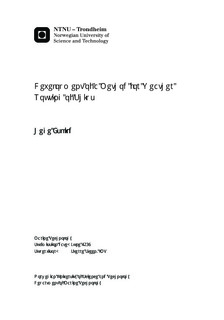| dc.description.abstract | Weather routing is a method within ship routing that is used to avoid rough weather and to find the minimal fuel, time or cost route between ports. Several methods and different software exit and are available to the ship owner or vessel. Three different methods are considered to be the main methods in weather routing: The modified isochrone method, calculus of variation and dynamic programming. In this thesis a shortest path algorithm is used to find the minimal fuel route. This method is similar to the dynamic programming, but the algorithm used to find the route is different. The vessel used for modeling is a 3500 twenty-foot equivalent unit (TEU) container vessel. The total resistance for a given sea state is defined as the sum of the calm water resistance, the wave added resistance and the wind added resistance. The safety of crew and cargo is ensured by implementing a set of seakeeping criteria. The seakeeping performance of the vessel is calculated with regard to roll, relative vertical acceleration, probability of slamming and probability of deck wetness. The mean added resistance due to waves and the vessel responses is calculated by spectral analysis, where the significant wave height and peak period are the spectral parameters. The MARINTEK program ShipX was used to calculate the motion transfer functions and the attainable speed for different sea states. Network optimization is used to solve the routing problem. A network of nodes and arcs is constructed between the two ports. The network defines the feasible region for the vessel, meaning all possible ship positions. The nodes are geographical coordinates and the arcs are defined as traveled path between nodes. Each node contains information about the significant wave height, mean wave period, mean wave direction and the U- and V-component of wind. Each arc is assigned a cost, which is the fuel consumption between two nodes. The fuel consumption is calculated by keeping the brake power constant, making the only unknown variable time. The time it takes to travel between two nodes is calculated as t=Distance/Velocity, where the velocity is dependent on the total resistance. A shortest path algorithm called Dijkstra's algorithm is used to solve the optimization problem.A Matlab program was developed to find the minimal fuel route. A GRIB file (GRIdded Binary) including weather data is needed to calculate the resistance and ship responses. In addition to the GRIB file, the input files needed in the program are output files from ShipX containing transfer functions and attainable speed for different sea states. The added resistance due to wind can be calculated either by using estimated wind velocity, or actual wind velocity, i.e. the wind components from the GRIB file. The program can run for all oceans and seasons. By changing the input files from ShipX the user can use this program to find optimal routes for different vessels.The Matlab program has been run for one vessel, but for different seasons and oceans. The main result obtained in this thesis is that weather routing does not result in fuel saving. The optimal route has approximately the same fuel consumption as the great circle route, meaning the shortest route on a sphere. It can therefore be concluded that the actual distance traveled has a much higher impact on fuel consumption than the added resistance. However, the program can be used to avoid rough weather. The route over the North Atlantic in January deviates from the great circle route, and the fuel consumption is higher. This is because the the roll responses exceeds the allowable roll standard deviation for a large part of feasible region, and the route chosen avoids this. The results also show that the optimal route for estimated and actual wind are almost identical. The fuel consumption for actual wind is consequently lower than for estimated wind. This is partly due to that the estimated wind velocity is overestimated, but mainly due to differences between how the velocity is calculated in Matlab and in ShipX. The overall conclusion is that weather routing can not be used to reduce the fuel consumption, but it is applicable to ensure safety of cargo and crew. | nb_NO |

